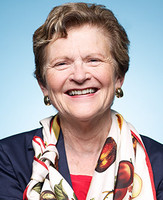- Any views expressed in this article are those of the author and not of CIMMYT.
EL BATAN, Mexico (CIMMYT) – Leading nutritionist Julie Miller Jones aims to bust myths about biotechnology

by educating the general population on the benefits she believes genetically engineered (GE) crops can play in ending extreme hunger and malnutrition.
A shift away from the perception that GE crops are unsafe for the environment and human health is needed if they are to live up to their potential to increase food production and improve nutrition to meet the needs of growing global population, said Miller Jones who will speak at a conference to mark the 50th anniversary of the International Maize and Wheat Improvement Center (CIMMYT) in September.
Hunger and malnutrition are barriers to sustainable development, because they lead to lowered productivity, diminished health and limit the ability to improve livelihoods, she said. There are nearly 800 million people who suffer from hunger worldwide, the majority in developing countries, according to the United Nations.
A recent report released by the U.S. National Academies of Sciences, Engineering and Medicine said there is no substantiated evidence that foods from GE crops are less safe than foods from non-GE crops. Miller Jones said the general public must be educated about how biotechnology can safely improve food crops and contribute to nourishing a global population projected to grow by more than 2 billion by 2050 to more than 9.7 billion.
GE technologies enable the insertion from one species to another of genetic material (DNA) responsible, for example, for the production of vitamin precursors, such as pro-vitamin A carotenoids. Specific genes from maize, daffodil or carrot, placed in a staple grain, can help address vitamin A shortages in many regions, said the nutritionist. Conventional breeding does not have this ability to insert desirable genes from one species to another, and GE technologies can therefore enhance the contribution of plant breeding in addressing significant public health problems, she said.
Miller Jones has followed wheat-breeding developments over the years. She is a big fan of Norman Borlaug, the late CIMMYT wheat breeder and 1970 Nobel Peace Prize laureate known as the Father of the Green Revolution for the high-yielding wheat varieties he produced, which are credited with saving more than a billion lives in the developing world.
Miller Jones is outspoken about the negative consequences of gluten-free diets and has written several research papers that dispel myths generated by claims that the protein found in wheat is unhealthy.
She is a certified nutrition specialist who is also a distinguished scholar and professor emeritus of nutrition of nutrition at St. Catherine University in St. Paul, Minnesota. Interested in all aspects of nutrition science, she is actively involved in educating consumers against myths about nutrition and food safety. Currently, she is a scientific advisor to a number of groups such as the Healthy Grains Institute and the Grains Food Foundation that promote healthy diets and educates consumers on the benefits the right balance of grain-based foods.
Jones, who will speak during Session Five on “Future Landscapes” at the CIMMYT 50th anniversary conference on Sept. 29, 2016, shared some insights on the future of agriculture in the following interview.
Q: What is significant about CIMMYT: What role has CIMMYT played in your area of work?
CIMMYT and Norman Borlaug have always been inspirations to me ever since I began my graduate work at the University of Minnesota nearly 50 years ago. I’m interested in nutrition and feeding the world, I taught students about the Green Revolution and the achievements of Borlaug and CIMMYT in the world food supply section of my class on current issues throughout my entire academic career.
Q: What are the key challenges the world faces?
Producing enough food and communicating about the risks and benefits of anything we do. Communicating that there are risks to using GE crops, but these are assessed on a case-by-case basis.. What hasn’t been communicated effectively, so that the average person can understand and not fear the technology, is the risk of not using GE and other agricultural advancements. It’s ironic to me that those claiming to be interested in the environment often reject technologies that enable the use of fewer inputs and scarce resources and they do it in the name of the environment. All must communicate this in a non-defensive, clear way.
Q: How does your area of specialization address these challenges?
As a nutritionist and communicator, I want to work with breeders to ensure that nutrients are one of the aspects that are included in breeding programs. Further, I want to work with others to develop effective strategies to explain advancements in agriculture and plant breeding to reduce consumers’ fears and ease their acceptance and adoption.
 Climate adaptation and mitigation
Climate adaptation and mitigation 
